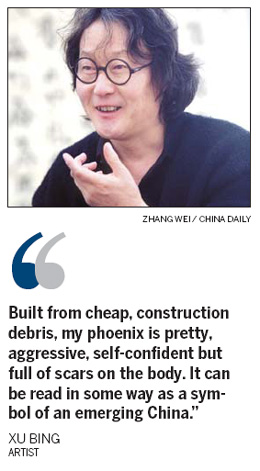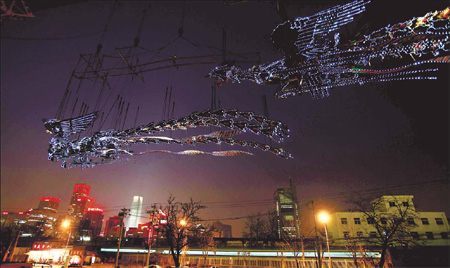A phoenix rises
|
Xu Bing's Aerial Phoenix that has two colossal metal "birds" suspended from eight cranes, tries to show the tension between wealth and poverty, capital and labor, tradition and modernity. Jiang Dong / China Daily |
A gigantic installation work made from construction debris purports to be a metaphor for contemporary China. Zhu Linyong reports
When Xu Bing returned from New York to serve as vice president of the Central Academy of Fine Arts in early 2008, the veteran artist said: "It is the enormous possibilities for artistic creation, arising amidst China's rapid, dramatic changes that has enchanted and drawn me back."
After two years of toil, Xu has turned his perception of the evolving nation into a gigantic Aerial Phoenix project, an outdoor installation made of construction site junk, including steel bars, safety helmets, fire hydrants and iron tubes, welded together into two facsimiles of the mythical bird.
The project made its public debut early this month on the square in front of Today Art Museum, near Beijing's Central Business District (CBD).
It is over 28 meters long, 8 meters wide, and weighs 12 tons, the two birds suspended by eight cranes, swinging, their metal jackets glistening in the sun.
At night, the two colossal objects resemble jet fighters or awe-inspiring transformers, floating in the air, emitting a mysterious light.
"This work is a kind of self-mocking, self-examining piece," Xu Bing says.
It is an installation piece, which borrows from modern Western art and the grassroots folk craft of zhi zha (paper models).
"Built from cheap, construction debris, my phoenix is pretty, aggressive, self-confident but full of scars on the body. It can be read in some way as a symbol of an emerging China," Xu says, adding his work is subject to various interpretations.
The project was first commissioned for a financial center in the CBD.
Xu's first idea was cranes, but this was vetoed by investors who, from a feng shui perspective, thought it would be a bad idea for an office building.
Then, Xu chose the phoenix, which is less used as a Chinese symbol than the dragon.
The project had a smooth start, Xu notes. However, economic turbulence over the past two years complicated matters.
"When the economic situation was good, the capitalists showed tolerance for art rendered in such a naughty way," Xu says.
"Unfortunately, the economic downturn damaged their confidence and they rejected my work and stopped funding."
But Xu did not give up the project.
It was completed late last year, with support from new investors.
"My team and I, including the migrant workers, learned a lot from this production process and from each other. And my understanding of this work is also deepening with each passing day," Xu says.
"The sheer physical presence and the story behind Xu's mythical birds has made it an allegory of social reality," curator Ouyang Jianghe says.
Film director Jia Zhangke has hailed Xu's efforts to balance capitalism and artistic integrity.
Yin Ji'nan, an art professor with the Central Academy of Fine Arts, describes Aerial Phoenix as "an innovative piece that breathes fresh air into the Chinese contemporary art scene".
He says Xu's work embodies a tension between wealth and poverty, capital and labor, tradition and modernity, Chinese-ness and globalism.
But Chen Xiaofeng, an independent critic from Beijing, lampoons Xu's work as "another clichd piece", following other well-known contemporary works making use of Chinese symbols by such artists as Huang Yongping, Gu Wenda, and Cai Guoqiang.
A document exhibition runs simultaneously with the installations at Today Art Museum, until Friday, with sketches, reports, photos, drafts, and models for the project, giving insight into the artist's meticulous, creative process.
After its Beijing debut, the project will move to Shanghai and be shown to audiences from around the globe at the Chinese pavilion of the Shanghai World Expo.

(China Daily 04/13/2010 page19)















